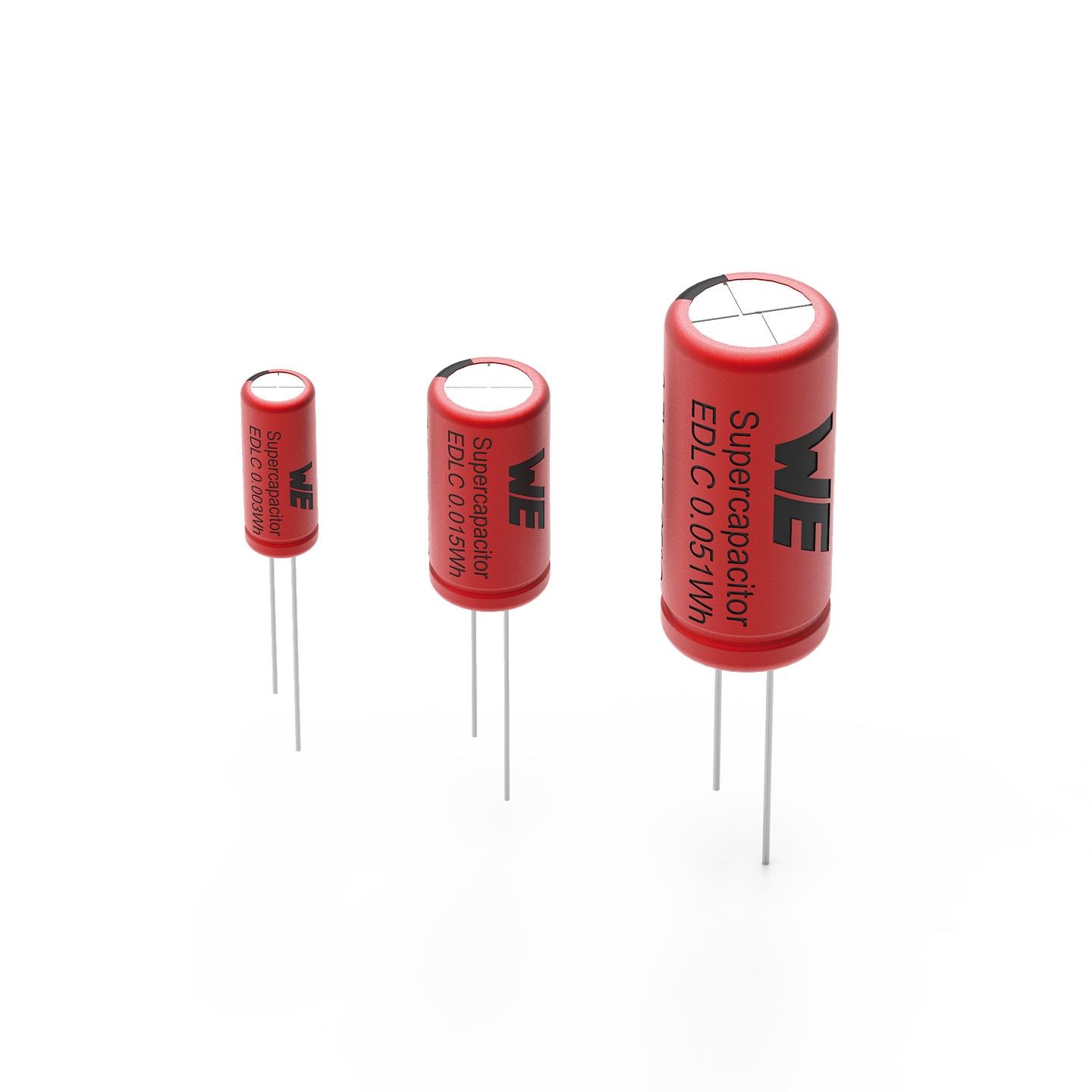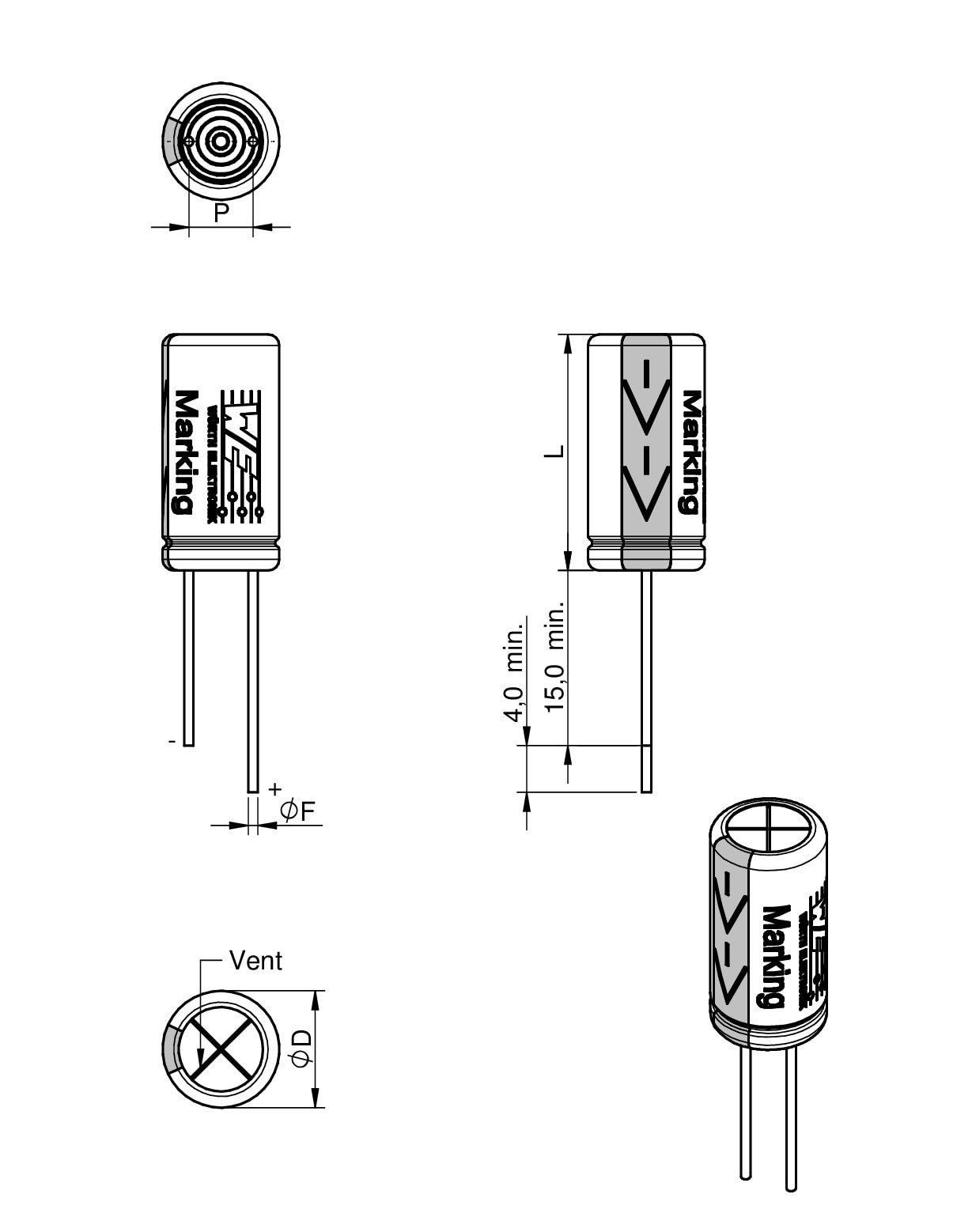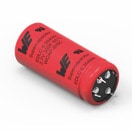LTSpice files
Characteristics
- Product series with standard cylindrical size
- Electric Double Layer Capacitors
- Higher energy density than usual capacitors
- Mounting style: Radial THT
- Life Cycles: 500000 Cycles
- Recommended soldering: Wave soldering
Applications
- Memory backup
- Smart meter
- Network equipment
- UPS systems
- Power assist
- Energy harvesting
EDLC-Calculator
Application Notes
- ANP077 Supercapacitor – A Guide for the Design-In Process
- ANP090 Keep the balance – Balancing of supercapacitors
- ANP109 Impedance Spectra of Different Capacitor Technologies
- ANP117 Impact of output capacitor on feedback loop stability of a power supply
- SN009: How to Use Supercapacitors?
- SN012: How does a Supercapacitor age? Lifetime Model of Electric Double Layer Capacitors
Products
| Order Code | Datasheet | Simulation | Downloads | Status | C | VR (V (DC)) | Life Cycle (Value) (Cycles) | Operating Temperature | RESR DC (mΩ) | RESR AC (mΩ) | ILeak (mA) | IMax (A) | IRated (A) | P (kW/ kg) | E (Wh/ kg) | Pitch (mm) | Ø D (mm) | L (mm) | Packaging | Samples |
|---|---|---|---|---|---|---|---|---|---|---|---|---|---|---|---|---|---|---|---|---|
| 850617030001 | SPEC | 9 files | Active i| Production is active. Expected lifetime: >10 years. | 3 F | 2.7 | 500000 | -40 °C up to +65 °C | 70 | 60 | 0.008 | 3.3 | 0.7 | 18.08 | 2.1 | 3.5 | 8 | 20 | Bulk | ||
| 850617021001 | SPEC | 9 files | Active i| Production is active. Expected lifetime: >10 years. | 5 F | 2.7 | 500000 | -40 °C up to +65 °C | 50 | 40 | 0.012 | 5.4 | 1.29 | 17.35 | 2.41 | 5 | 10 | 20 | Bulk | ||
| 850617021002 | SPEC | 9 files | Active i| Production is active. Expected lifetime: >10 years. | 7 F | 2.7 | 500000 | -40 °C up to +65 °C | 45 | 35 | 0.02 | 7.1 | 1.7 | 18.92 | 3.3 | 5 | 10 | 20 | Bulk | ||
| 850617021004 | SPEC | 9 files | Active i| Production is active. Expected lifetime: >10 years. | 10 F | 2.7 | 500000 | -40 °C up to +65 °C | 35 | 30 | 0.03 | 10 | 2.5 | 19.1 | 3.7 | 5 | 10 | 25 | Bulk | ||
| 850617021005 | SPEC | 10 files | Active i| Production is active. Expected lifetime: >10 years. | 15 F | 2.7 | 500000 | -40 °C up to +65 °C | 33 | 30 | 0.06 | 13.5 | 3.6 | 12.27 | 3.3 | 5 | 13 | 25 | Bulk | ||
| 850617022001 | SPEC | 9 files | Active i| Production is active. Expected lifetime: >10 years. | 25 F | 2.7 | 500000 | -40 °C up to +65 °C | 25 | 20 | 0.068 | 20.7 | 6 | 10.72 | 3.7 | 7.5 | 16 | 25 | Bulk | ||
| 850617022002 | SPEC | 9 files | Active i| Production is active. Expected lifetime: >10 years. | 50 F | 2.7 | 500000 | -40 °C up to +65 °C | 20 | 15 | 0.105 | 33.7 | 11.2 | 8.13 | 4.5 | 7.5 | 18 | 40 | Bulk |
| Order Code | Datasheet | Simulation |
|---|---|---|
| 850617030001 | SPEC | |
| 850617021001 | SPEC | |
| 850617021002 | SPEC | |
| 850617021004 | SPEC | |
| 850617021005 | SPEC | |
| 850617022001 | SPEC | |
| 850617022002 | SPEC |
| Samples |
|---|
| Order Code | Datasheet | Simulation | Downloads | Status | C | VR (V (DC)) | Life Cycle (Value) (Cycles) | Operating Temperature | RESR DC (mΩ) | RESR AC (mΩ) | ILeak (mA) | IMax (A) | IRated (A) | P (kW/ kg) | E (Wh/ kg) | Pitch (mm) | Ø D (mm) | L (mm) | Packaging | Samples |
|---|
Products of interest
Videos
#askLorandt explains: Supercapacitors and the difference to conventional capacitors and batteries
Videos
#askLorandt explains: How to use Supercapacitors in the industrial environment as best as possible
Videos
The Supercapacitor – A Versatile Energy Storage Device and How to Use it.
Videos
WE meet @ Digital Days 2021:WE backup your application; hot swappable supercapacitor backup solution
Videos
Würth Elektronik Webinar: Keep the balance – How to balance Supercapacitors
Videos
Webinar: Introduction to the capacitor technologies and how to use them


